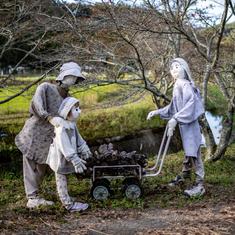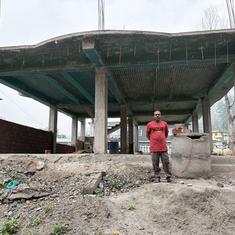“I wanted to write a book that entertains people while educating and informing them about the landscapes, culture, myths, and quiet philosophies embedded in the lives of the people from Arunachal Pradesh,” said Subi Taba in one of our exchanges. True to her maxim, the ten tales about the dawn-lit mountains of Arunachal Pradesh become an excursion into the volatile yet extraordinary lives lived on the margins of time and space. These stories reiterate that the co-existence of man and nature is as essential as it is primitive. Any attempt to disrupt this equilibrium creates a cleft, insurmountable and sometimes, irreversible.
The people of the hinterland
For Taba, the stories included in the collection Tales from the Dawn-lit Mountains have emerged out of longing. The fondness for home, elders and community tie most of the stories together. Yet, they retain their individuality. In the story, “A Night with the Tiger,” Taba hints at the animosity of harming nature quite early on, replaying the same theme in many other stories where nature eventually haunts the hunter. What starts off as surreal becomes believable because of the foretelling of elders. At once, therefore, the story conjures up a past that relies on the community’s knowledge of omens and blessings. A man-tiger, unlikely as it might be, morphs into a metaphor for man’s corrupting grasp on the non-human and the consequences thereof.
Stories such as “Curse of the High Priest”, “Plant, Pig and Woman,” and “Spirit of the Forest” further the element of the uncanny, explaining Taba’s assertion that in order to make the fantastical familiar, she has to treat it with the “same emotional seriousness as the real.” The narrative here is also an extension of the Indigenous worldviews that do not distinguish between the mythic and the tangible. Taba’s insistence that these stories “honour the logic of its own world” is heightened when the curse of a senior priest materialises, destroying a family, when the souls of a pig and a plant give a tortured woman company, or when the spirit of the forest conspires to kill a greedy capitalist.
The stories deal with temporality non-linearly. While the primordial world shares space with WhatsApp-driven aspects of modernity, its momentum is limited by the temporal distance it shares with the present. The characters inhabiting these liminal spaces have predestined fates and, despite exerting their agencies or, as the author states, “finding small but powerful moments of resistance, introspection, and even transformation”, are frozen in karmic time. Stories which consistently carry the relevance of fates are “The Lost Village,” “Love and Longing in Seijosa,” and “A Man from China.” Here, the lives of the characters come full circle at moments of crisis. It is fate working for the girl who spends years looking for the remaining pieces of a story her grandmother told her as a child, and fate indeed when a father’s longing manifests his daughter’s visit after years of estrangement, but only when it is too late.
Nostalgia for a bygone era is indeed an overarching theme. Reminiscence about the past is found especially in the stories, “The Last Donyi-polo Priest” and “Macabre Memories of a Head-hunter.” The protagonists’ experientiality, narrated in a modern world, provides incisive glimpses into the trajectories societies have taken through the course of Arunachal’s history. Beheading defeated warriors was the norm to mark victory in most tribal societies which changed with the arrival of Christianity. Similarly, shamanic practices of fortune-telling came to a halt after education became common. Such changes altered discourses about what was considered permissible and thereafter forbidden. Again, tales like “The Cobra Man” and “Love and Longing in Seijosa” are also remarkable for their conservational appeal. As the writer confirms, her job as an agricultural officer helped her shape the rather purposeful discourse in these tales.
The poetics and politics
Subi Taba is firstly, a poet. Her imagination is as vivid as her understanding of the natural world she describes. “It comes naturally to me because I like to think about my story scenes in images, in sounds, and in sensory rhythms. I enjoy the art of fashioning words in different forms and styles. I think being a sensitive and emotional person helps me think poetically. I like to associate the emotions of the characters of my stories to a certain musicality. And I believe the landscapes I write about – lush, haunting, untamed – demand a poetic response,” she makes her poetry accessible.
It is interesting to see how the landscapes of communal life transform into lingering images, awestruck and appealing throughout the narrative. The desperate need to belong is a primary concern, as seen in the way the characters try to demarcate their territories within the hinterlands that are bountiful and ensnaring. Taba’s stylistics is also equally detailed and highly sonorous – much like the rivers Kameng and Siang that occupy centrality in her prose. No part of her narrative is repetitive. Even when she describes the most mundane occurrence, her perceptive poetry weaves subtle imageries around these events. In her expertise as the beholder of stories paramount in the hinterlands, Taba laces a tapestry of solidarity and understanding. There are no villains in these tales, only survivors with pivotal struggles.
In the undercurrent of these scenic descriptions are also evident traces of her politics and what it means to occupy space tormented by wants of a rapidly changing society. “Politics is never absent in a place like Arunachal Pradesh – it’s written into the land, the rivers, even the silence,” the writer admits. The collective struggle of the populace, reflected by the commonality of their existence, carries questions of identity, religion and ecological degradation- questions that need thorough political reasoning as answers. The co-existence of the new with the old order of mankind that Taba employs in her plots seamlessly blends into one another, at times, also tearing into the fabric of time.
In her acknowledgement, Taba notes that she has taken “creative liberties to fictionalise glimpses and layers of cultural history, familial ties, ethnographic identity, symbolism of animals, geopolitical transition, life’s mundanity, nature and supernatural beliefs” found amongst the tribal populace of the state. Yet, how continuous these liberties are, one is bound to wonder, for they fit into the narrative without making the real obscure.
Taba’s search for the stories relied on her studying even “the shape of the clouds and the hills, and the vegetation” of certain villages. One can only expect a writer of her calibre to be observant and deeply emphatetic – just like the characters she talks about. In fact, these tales appear to be the beginning of a rather promising literary career. Taba hopes that in time, her work would expand to explore “the intersection of folklore, shamanism, and oral traditions – but on a much larger canvas.” There is no doubt that a work like that will give readers another set of perspectival glances into lives less understood.

Tales from the Dawn-Lit Mountains: Stories from Arunachal Pradesh, Subi Taba, Penguin India.










